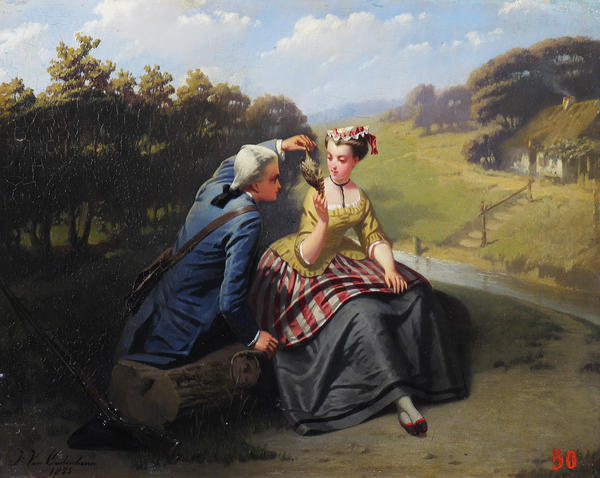The back side of the painting features a label with a torn corner that bears the inscription I, the undersigned, declare that I created the painting on the other side, depicting a successful hunt.
Van Oudenhoven. Brussels, May 10, 1856. In the catalogue of the Radishchev Museum in 1969, the painting was published with the title Hunter Bringing a Dead Bird to the Lady. The inscription on the back gives reason to restoring the artist’s title to the painting. Little is known about the life and work of Belgian artist Joseph van Oudenhoven. He worked in Antwerp in the middle of the 19th century and painted genre works.
In recent decades, his works can be found at international sales. Most of them look like the painting from our collection and feature gallant scenes in the spirit of the 18th century, mostly painted on wood, small-sized, signed and dated in the middle of the 19th century.
The painting is like a scene from a play. It is a landscape with a hut in the background resembling theatrical scenery in a play about rural life. A bird has traditionally been considered a symbol of female chastity. Thus, this theme can be interpreted as a scene of seduction, and the title of the painting can be understood in two ways, both literally and figuratively. An attentive viewer will find several 18th to 19th centuries paintings with similar message in the collection of the Radishchev Museum. The 19th century is called the era of historicism due to the increased interest in history.
The lady and gentleman are dressed in fashion of 18th century, when lush and sophisticated rococo style, favorite style of French king Louis XV dominated in Europe. By the middle of the century, women’s dress became even more elaborate in silhouette. The skirt was still based on crinoline, like at the beginning of the century, but grew fuller on the sides and had an elliptic shape. Because of this, a gentleman could not even walk side by side with a lady, but walked a little ahead from her instead, holding her hand. The lady wore two skirts, as was customary at the time. The corseted bodice was narrow and had a deep square neckline, trimmed with flounces.
The lady on the painting wears a headdress that is similar to a cap, but smaller. Her rather modest attire suggests that she does not belong to noble class. Her costume resembles the clothing of girls and women of the bourgeoisie, who were favorite characters of famous French artist of the 18th century Jean Baptiste Chardin. The fact that the lady and the gentleman belong to different social classes is also highlighted by their hairstyles, as the chevalier’s hair is powdered, while the lady has natural-colored blond hair.



